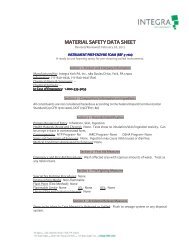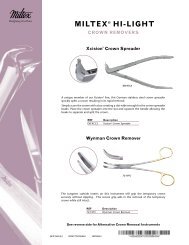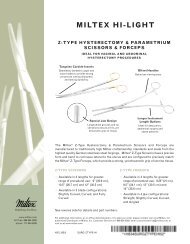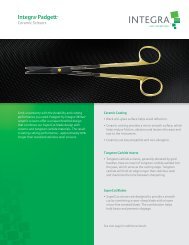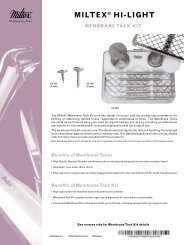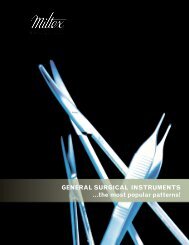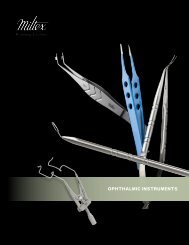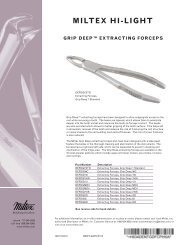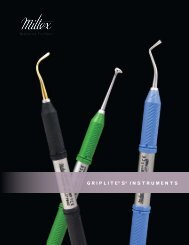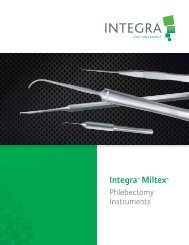Catalog - Hygiene - Integra Miltex
Catalog - Hygiene - Integra Miltex
Catalog - Hygiene - Integra Miltex
You also want an ePaper? Increase the reach of your titles
YUMPU automatically turns print PDFs into web optimized ePapers that Google loves.
I n s t r u m e n t C A R E I N S T R U C T I O N S<br />
• Cutting edge instruments and knives should be sharp<br />
and free of damage.<br />
• After scrubbing, rinse instruments thoroughly under<br />
running water. While rinsing, open and close scissors,<br />
hemostats, needle holders and other hinged<br />
instruments to ensure that hinged areas are rinsed<br />
out and that no debris remains.<br />
4. After Cleaning<br />
Separate dissimilar metals prior to sterilizing/autoclaving.<br />
If instruments will be stored, allow them to air-dry and store<br />
them in a clean and dry environment.<br />
5. AUTOCLAVING<br />
A. Lubricate all hinged instruments which have any<br />
“metal to metal” action at the screw or box lock. A<br />
non-silicone, water-soluble surgical lubricant such as<br />
<strong>Miltex</strong> ® Lube (3-700 or 3-705) is recommended.<br />
Do not use industrial oils or lubricants.<br />
B. Sterilize instruments either individually or in sets.<br />
• Individual Instruments: Disposable paper or plastic<br />
pouches are ideal. Make sure to use a wide enough<br />
pouch for instruments with ratchet locks so<br />
instruments can be sterilized in an open (unlocked)<br />
position. Instruments locked during autoclaving can<br />
develop cracked hinges (box locks) or other<br />
problems because of heat expansion. If wrapping<br />
instruments, make sure the towel does not contain<br />
detergent residue which can stain instruments.<br />
• Instrument Sets: Unlock all instruments and sterilize<br />
in an open position. Place heavy instruments on the<br />
bottom of set (when two layers are required). Do not<br />
overload the chamber because an air pocket<br />
that hinders steam penetration may form.<br />
CAUTION: With most portable tabletop autoclaves, unlock<br />
the door and open it no more than a crack, about 1/4” (6.4 mm).<br />
(at the end of the autoclave cycle and before the drying cycle)<br />
Then run the dry cycle for the period recommended by the autoclave<br />
manufacturer. If the autoclave door is fully opened before<br />
the drying cycle, cold air will rush into the chamber and will<br />
cause condensation on the instruments, potentially resulting in<br />
water stains or causing wet packs. Make sure autoclave filters<br />
and chambers are cleaned as recommended by the<br />
manufacturer. <strong>Miltex</strong> ® Surgical Instrument Stain Remover<br />
(3-740) is effective in removing stains and in cleaning the<br />
autoclave chamber. If you have any unusual staining on your<br />
instruments after sterilization, obtain our Instrument Care<br />
System DVD (3-810) or contact your local<br />
<strong>Miltex</strong> ® representative.<br />
6. chemical/COLD STERILIZATION<br />
Most chemical/cold sterilization solutions render instruments<br />
sterile only after 10-hour immersion. This prolonged chemical<br />
action can be more detrimental to instruments than the usual<br />
20-minute autoclave cycle. If the instruments need to be<br />
“disinfected” only, a chemical/cold sterilization soak is<br />
acceptable, as disinfection will take approximately 10<br />
minutes or more. Check manufacturers’ specifications.<br />
Also see our warning in using bleach (paragraph 3).<br />
Keep in mind the difference between:<br />
• Sterile - an absolute term (no living organism survives); and<br />
• Disinfected - basically clean. Some organisms may<br />
survive. Always use the proper sterilization/cleaning<br />
technique to render the instrument in the required<br />
condition for use.<br />
CAUTION: For instruments with tungsten carbide insert jaws,<br />
the use of chemical/cold sterilization solutions is not recommended<br />
as it may deteriorate the instrument’s jaw.<br />
We recommend these <strong>Miltex</strong> products to properly safeguard<br />
and care for your quality instruments.<br />
REF Description Use During<br />
3-760<br />
3-750<br />
3-755<br />
Instrument Prep Enzyme Foam<br />
24 oz. spray<br />
EZ-Zyme ® , All Purpose Enzyme<br />
Cleaner Box 32 - 3/4 oz. packets<br />
EZ-Zyme ® , All Purpose Enzyme<br />
Cleaner 1-gallon pump bottle<br />
3-700 Spray Lube 8 oz. spray bottle<br />
3-705<br />
Surgical Instrument Lubricant<br />
1-gallon pump bottle<br />
3-710<br />
3-720<br />
3-725<br />
3-726<br />
3-740<br />
3-1000<br />
3-1001<br />
Surgical Instrument Cleaner &<br />
Lubricant 1-gallon pump bottle<br />
Surgical Instrument Cleaner<br />
8 oz. spray bottle<br />
Surgical Instrument Cleaner<br />
1-gallon pump bottle<br />
Surgical Instrument Cleaner<br />
Box 80 - 1/4 oz. packets<br />
Surgical Instrument Stain<br />
Remover 3 oz. jar<br />
Nylon Instrument Cleaning<br />
Brushes 3-pack<br />
Stainless Steel Instrument<br />
Cleaning Brushes 3-pack<br />
• Holding & presoak<br />
• Holding & presoak<br />
• Soak cleaning<br />
• Ultrasonic cleaning<br />
• Manual cleaning<br />
• Laundry presoak<br />
• Before autoclaving<br />
• Manual cleaning<br />
• Washer/decontaminator<br />
• Ultrasonic cleaning<br />
• Soak cleaning<br />
• Ultrasonic cleaning<br />
• Manual cleaning<br />
• Stain removal<br />
• Manual cleaning of<br />
instruments<br />
3-800 Instrument Care System • Complete instrument care<br />
3-810 Instrument Care DVD<br />
• Training personnel in<br />
the care of instruments<br />
68<br />
www.miltex.com



